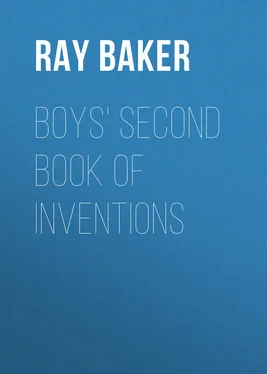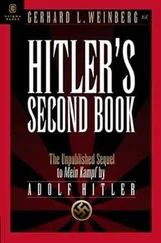But first for a glimpse at the curious earthquake measurer itself. To begin with, there are two kinds of instruments – one to measure near-by disturbances, and the second to measure waves which come from great distances. The former instrument was used by Professor Milne in Japan, where earthquakes are frequent; the latter is used in England. The technical name for the machine which measures distant disturbances is the horizontal pendulum seismograph, and, like most wonderful inventions, it is exceedingly simple in principle, yet doing its work with marvellous delicacy and accuracy.
In brief, the central feature of the seismograph is a very finely poised pendulum, which is jarred by the slightest disturbance of the earth, the end of it being so arranged that a photograph is taken of every quiver. Set a pendulum clock on the dining-table, jar the table, and the pendulum will swing, indicating exactly with what force you have disturbed the table. In exactly the same way the delicate pendulum of the earthquake measurer indicates the shaking of the earth.
The accompanying diagram gives a very clear idea of the arrangement of the apparatus. The "boom" is the pendulum. It is customary to think of a pendulum as hanging down like that of a clock, but this is a horizontal pendulum. Professor Milne has built a very solid masonry column, reaching deep into the earth, and so firmly placed that nothing but a tremor of the hard earth itself will disturb it. Upon this is perched a firm metal stand, from the top of which the boom or pendulum, about thirty inches long, is swung by means of a "tie" or stay. The end of the boom rests against a fine, sharp pivot of steel (as shown in the little diagram to the right), so that it will swing back and forth without the least friction. The sensitive end of the pendulum, where all the quakings and quiverings are shown most distinctly, rests exactly over a narrow roll of photographic film, which is constantly turned by clockwork, and above this, on an outside stand, there is a little lamp which is kept burning night and day, year in and year out. The light from this lamp is reflected downward by means of a mirror through a little slit in the metal case which covers the entire apparatus. Of course this light affects the sensitive film, and takes a continuous photograph of the end of the boom. If the boom remains perfectly still, the picture will be merely a straight line, as shown at the extreme right and left ends of the earthquake picture on this page. But if an earthquake wave comes along and sets the boom to quivering, the picture becomes at once blurred and full of little loops and indentations, slight at first, but becoming more violent as the greater waves arrive, and then gradually subsiding. In the picture of the Borneo earthquake of September 20, 1897, taken by Professor Milne in his English laboratory, it will be seen that the quakings were so severe at the height of the disturbance that nothing is left in the photograph but a blur. On the edge of the picture can be seen the markings of the hours, 7.30, 8.30, and 9.30. Usually this time is marked automatically on the film by means of the long hand of a watch which crosses the slit beneath the mirror (as shown in the lower diagram with figure 3). The Borneo earthquake waves lasted in England, as will be seen, two hours fifty-six minutes and fifteen seconds, with about forty minutes of what are known as preliminary tremors. Professor Milne removes the film from his seismograph once a week – a strip about twenty-six feet long – develops it, and studies the photographs for earthquake signs.
Besides this very sensitive photographic seismograph Professor Milne has a simpler machine, not covered up and without lamp or mirror. In this instrument a fine silver needle at the end of the boom makes a steady mark on a band of smoked paper, which is kept turning under it by means of clockwork. A glance at this smoked-paper record will tell instantly at any time of day or night whether the earth is behaving itself. If the white line on the dark paper shows disturbances, Professor Milne at once examines his more sensitive photographic record for the details.
Конец ознакомительного фрагмента.
Текст предоставлен ООО «ЛитРес».
Прочитайте эту книгу целиком, купив полную легальную версию на ЛитРес.
Безопасно оплатить книгу можно банковской картой Visa, MasterCard, Maestro, со счета мобильного телефона, с платежного терминала, в салоне МТС или Связной, через PayPal, WebMoney, Яндекс.Деньги, QIWI Кошелек, бонусными картами или другим удобным Вам способом.
In the first "Boys' Book of Inventions," the author devoted a chapter entitled "Through the Air" to the interesting work of the inventors of flying machines who have experimented with aëroplanes; that is, soaring machines modelled after the wings of a bird. The work of Professor S. P. Langley with his marvellous Aërodrome, and that of Hiram Maxim and of Otto Lilienthal, were given especial consideration. In the present chapter attention is directed to an entirely different class of flying machines – the steerable balloons.












